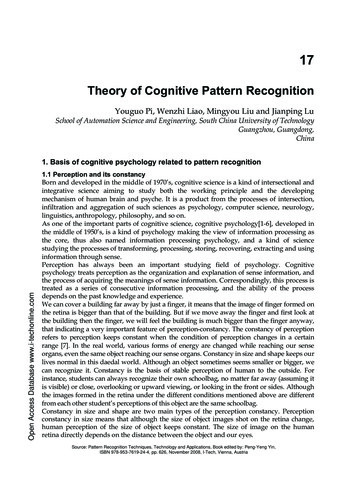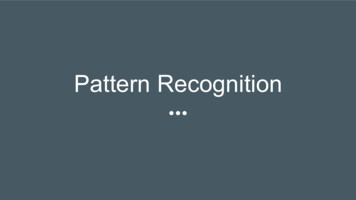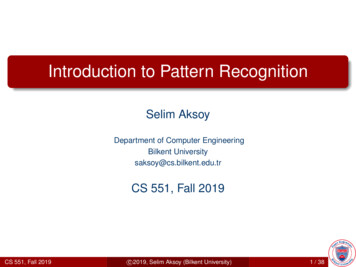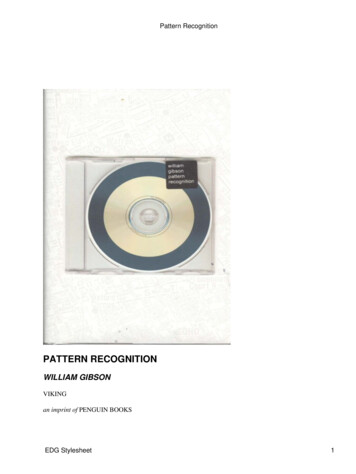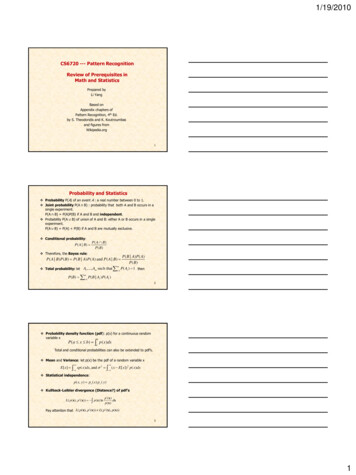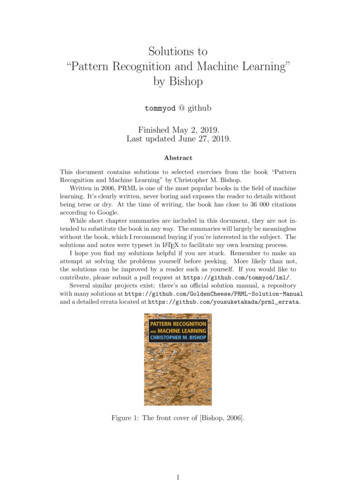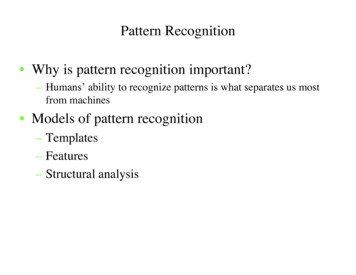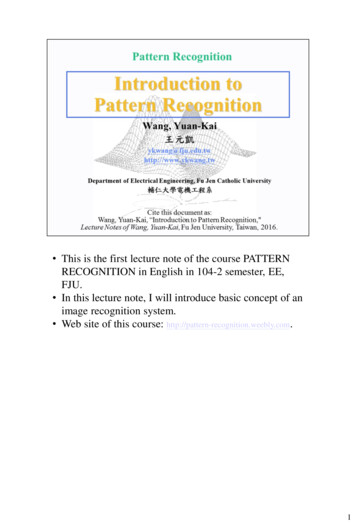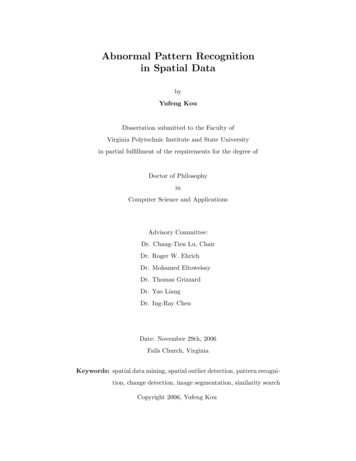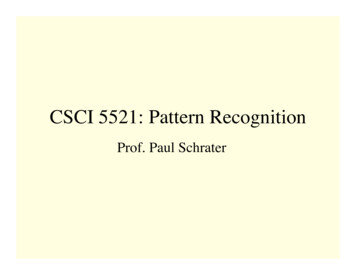
Transcription
CSCI 5521: Pattern RecognitionProf. Paul Schrater
Business Course web page:http://gandalf.psych.umn.edu/ schrater/schrater lab/courses/PattRecog07/PattRecog.htmlProf. Paul SchraterPattern Recognition CSCI 55212
Syllabus Reading materials:– Pattern Classification, 2nd Ed. Duda, Hart, Stork– Statistical Pattern Recognition, 2nd Ed. Andrew Webb– Elements of Statistical Learning: Data Mining, Inference, Prediction,Trevor Hastie, Robert Tibshirani, and Jerome Friedman. Springer,2001.– Gaussian Processes for Machine Learning, Carl Rasmussen andChristopher K.I. Williams, MIT Press, 2006.– Papers posted on the web site.– Downloads will be password protected. Grading 60% on the homework assignments 40% on the final project.Prof. Paul SchraterPattern Recognition CSCI 55213
Syllabus cont’d Final Project12-15 page paper involving:1) Simulation or experiments. For example, implement a patternrecognition system for a particular application, e.g. digitclassification, document clustering, etc.2) Literature survey (with critical evaluation) on a given topic.3) Theoretical work (detailed derivations, extensions of existingwork, etc)Important dates: Sept. 28: Topic selection. One or two pages explaining theproject with a list of references.Nov. 7: Partial report (3 to 5 pages).Dec. 20: Final report (12 to 15 pages). Students may work in groups of 2-4.Prof. Paul SchraterPattern Recognition CSCI 55214
Policies/Procedures DO NOT CHEAT. Do NOT work in groups for homework(consulting with fellow students permitted,but group submissions are not). Electronically submit homework. Homework must be submitted by Midnighton the day it is due.Prof. Paul SchraterPattern Recognition CSCI 55215
Introduction to PatternRecognition Syllabus What are Patterns? Pattern Recognition An Example Pattern Recognition Systems The Design Cycle Learning and Adaptation Conclusion
Examples of PatternsProf. Paul SchraterPattern Recognition CSCI 55217
Examples of PatternsNatural orNot?How can wedescribe thesepatterns?Prof. Paul SchraterPattern Recognition CSCI 55218
Shape PatternsD’arcy Thompson’s suggestion ofspecies change throughcontinuous deformationProf. Paul SchraterThis figure shows the effects ofAlzheimer's Disease on the ventricularexpansion rate measured from serial MRI.Pattern Recognition CSCI 55219
Explaining patternsProf. Paul SchraterPattern Recognition CSCI 5521Voice Puppetry, M. Brand;Siggraph’9910
Pattern ExamplesProf. Paul SchraterPattern Recognition CSCI 552111
Pattern ExamplesNatural Language is a patternProf. Paul SchraterPattern Recognition CSCI 552112
What is a Pattern? A set of instances that:– Share some regularities and similarities.– Are Repeatable.– Are Observable, sometimes partially, using sensorswith noise and distortions. How do we define “regularity”? How do we define “similarity”? How do we define “likelihood” for the repetitionof a pattern? How do we model the sensors? What is not a pattern?Prof. Paul SchraterPattern Recognition CSCI 552113
Defining PatternsIn a mathematical notation, Ulf Grenander (1976-1995)propose to define patterns as follows:Regularity R G, S, ρ, Σ G --- a set/space of generators (the basic elements in apattern), each generator has a number of “bonds” thatcan be connected to neighbors. S --- a transformation group (such as similarity transform)for the generators· ρ--- a set of local regularities (rules for the compatibilityof generators and· Σ--- a set of global configurations (graphs with generatorsbeing vertices and connected bonds being edges).Prof. Paul SchraterPattern Recognition CSCI 552114
ConceptIllustrationBasic description - Points with connectionsρΣSProf. Paul SchraterPattern Recognition CSCI 552115
Two Schools of Pattern Rec. Generative methods:Bayesian school, pattern theory. The goal is to learn a complete modelfor the pattern - one capable of generating new instances.1). Specify patterns in terms of measurable signals2). Specify likelihood model for how signals are generated from hiddenstructures3). Learning probability models on hidden structures from ensemble ofsignals4). Infer generating causes from particular signals. Discriminative methods:– The goal is to tell apart a number of patterns, say 100 people, 10digits, directly, without causes or mathematical description ofpattern generating mechanisms.– “Don’t oversolve your problem”.Prof. Paul SchraterPattern Recognition CSCI 552116
Pattern Recognition applications Build a machine that can recognize patterns:– Speech recognition– Fingerprint identification– OCR (Optical Character Recognition)– DNA sequence identification– Text ClassificationProf. Paul SchraterPattern Recognition CSCI 552117
An Example “Sorting incoming Fish on a conveyoraccording to species using optical sensing”Sea bassSpeciesSalmonProf. Paul SchraterPattern Recognition CSCI 552118
Problem Analysis– Set up a camera and take some sample images to extract features LengthLightnessWidthNumber and shape of finsPosition of the mouth, etc This is the set of all suggested features to explore for use in our classifier!Prof. Paul SchraterPattern Recognition CSCI 552119
PreprocessingFeature ExtractionClassificationSegment fish fromBackgroundImage data from each fishSummarized by feature extractorwhose purpose is to reduce thedata by measuring certain featuresThe features are passedto a classifier, that uses thefeatures to decide whichclass the instance belongsto.20Prof. Paul SchraterPattern Recognition CSCI 5521
Prof. Paul SchraterPattern Recognition CSCI 552121
The length is a poor feature alone!Select the lightness as a possiblefeature.Prof. Paul SchraterPattern Recognition CSCI 552122
Prof. Paul SchraterPattern Recognition CSCI 552123
Threshold decision boundary and cost relationship– Move our decision boundary toward smaller values oflightness in order to minimize the cost (reduce thenumber of sea bass that are classified salmon!)Task of decision theoryProf. Paul SchraterPattern Recognition CSCI 552124
Adopt the lightness and add the width of thefishFishxT [x1, x2]LightnessProf. Paul SchraterPattern Recognition CSCI 5521Width25
Prof. Paul SchraterPattern Recognition CSCI 552126
We might add other features that are not correlatedwith the ones we already have. A precaution shouldbe taken not to reduce the performance by addingsuch “noisy features” Ideally, the best decision boundary should be theone which provides an optimal performance such asin the following figure:Prof. Paul SchraterPattern Recognition CSCI 552127
Prof. Paul SchraterPattern Recognition CSCI 552128
However, our satisfaction is premature becausethe central aim of designing a classifier is tocorrectly classify novel inputIssue of generalization!Prof. Paul SchraterPattern Recognition CSCI 552129
Prof. Paul SchraterPattern Recognition CSCI 552130
Pattern Recognition Systems Sensing– Use of a transducer (camera or microphone)– PR system depends of the bandwidth, the resolutionsensitivity distortion of the transducer Segmentation and grouping– Patterns should be well separated and should notoverlapProf. Paul SchraterPattern Recognition CSCI 552131
Prof. Paul SchraterPattern Recognition CSCI 552132
Feature extraction– Discriminative features– Invariant features with respect to translation, rotation and scale. Classification– Use a feature vector provided by a feature extractor to assign theobject to a category Post Processing– Exploit context: input dependent information other than from thetarget pattern itself to improve performanceProf. Paul SchraterPattern Recognition CSCI 552133
The Design Cycle Data collectionFeature ChoiceModel ChoiceTrainingEvaluationComputational ComplexityProf. Paul SchraterPattern Recognition CSCI 552134
Prof. Paul SchraterPattern Recognition CSCI 552135
Data Collection– How do we know when we have collected anadequately large and representative set ofexamples for training and testing the system?Prof. Paul SchraterPattern Recognition CSCI 552136
Feature Choice– Depends on the characteristics of the problemdomain.– Feature desirata: Simple to extract, invariant to irrelevant transformations insensitive to noise.Prof. Paul SchraterPattern Recognition CSCI 552137
Model Choice– Unsatisfied with the performance of our fishclassifier and want to jump to another class ofmodelProf. Paul SchraterPattern Recognition CSCI 552138
Training– Use data to determine the classifier. Manydifferent procedures for training classifiers andchoosing modelsProf. Paul SchraterPattern Recognition CSCI 552139
Evaluation– Measure the error rate (or performance) andswitch from one set of features to anotherProf. Paul SchraterPattern Recognition CSCI 552140
Computational Complexity– What is the trade-off between computationalease and performance?– (How an algorithm scales as a function of thenumber of features, patterns or categories?)Prof. Paul SchraterPattern Recognition CSCI 552141
Learning and Adaptation Supervised learning– A teacher provides a category label or cost for eachpattern in the training set Unsupervised learning– The system forms clusters or “natural groupings” of theinput patterns Reinforcement Learning/Semi-supervised– Environment provides feedback indicating the qualityof decisions, but no labeled examples.Prof. Paul SchraterPattern Recognition CSCI 552142
Conclusion The number, complexity and magnitude of thesub-problems of Pattern Recognition areformidable. Many of these sub-problems can indeed be solved Many fascinating unsolved problems still remainProf. Paul SchraterPattern Recognition CSCI 552143
Prof. Paul Schrater Pattern Recognition CSCI 5521 4 Syllabus cont’d Final Project 12-15 page paper involving: 1) Simulation or experiments. For example, implement a pattern recognition system for a particular application, e.g. digit classification, document clustering, etc. 2) Liter
